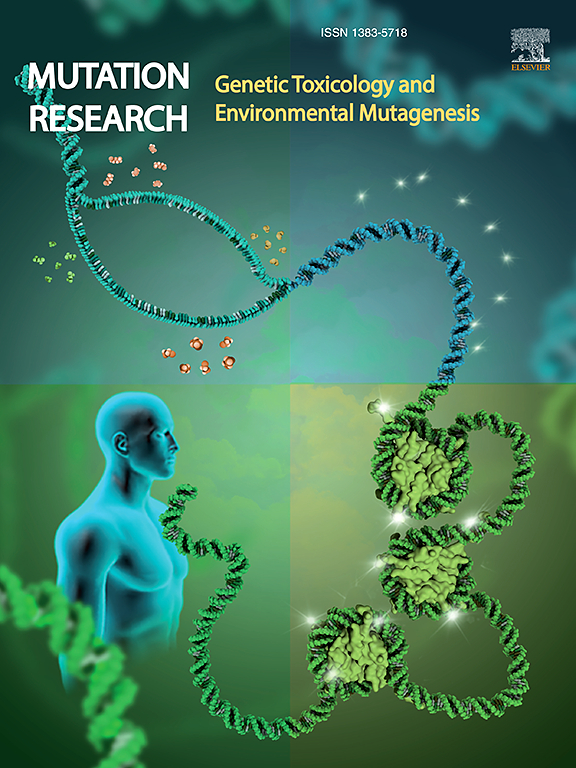在DNA损伤和修复方面,全血储存条件对彗星测定的影响是什么?
IF 2.5
4区 医学
Q3 BIOTECHNOLOGY & APPLIED MICROBIOLOGY
Mutation research. Genetic toxicology and environmental mutagenesis
Pub Date : 2025-02-01
DOI:10.1016/j.mrgentox.2025.503851
引用次数: 0
摘要
彗星法是一种在单个细胞水平上快速、简便、灵敏地检测DNA损伤和修复的方法,在人体生物监测和分子流行病学中有着广泛的应用。通常的做法是对新鲜样本进行彗星分析,以保持DNA的完整性并获得可靠的结果,这就是为什么大多数已发表的研究都是使用新鲜血液样本设计的。使用新鲜样品进行检测有一定的局限性,一些研究需要适当的储存。本研究的目的是确定在不添加冷冻保鲜剂的情况下,中长期保存人全血(WB)样本时DNA损伤和DNA修复动力学的变化。全血样本分成小份,在+ 4°C下保存过夜后进行检测。冷冻样品在- 20和- 80°C下保存3个不同的时间点:30,90和180天。将冷冻样品与+ 4°C保存的新鲜样品在DNA损伤和修复方面进行比较。对于储存在- 80°C的WB样品,可以确定嘌呤碱基损伤(PBD)和DNA修复改变的增加,而基础DNA损伤没有增加。根据我们的研究结果,小份WB样品在- 20°C下保存90天不会造成任何额外的损伤,也不会导致任何DNA修复动力学的改变。本文章由计算机程序翻译,如有差异,请以英文原文为准。
What are the effects of whole blood storage conditions on comet assay in terms of DNA damage and repair?
The comet assay is a rapid, simple and sensitive method for the detection of DNA damage and repair at the level of individual cells, with a wide range of applications in human biomonitoring and molecular epidemiology. It is common practice to perform the comet assay on fresh samples to preserve the integrity of the DNA and to obtain reliable results, which is why most published studies have been designed using fresh blood samples. There are limitations associated with the use of fresh samples for this assay and the need for appropriate storage for some studies. The aim of this study was to determine changes in DNA damage and DNA repair kinetics during medium- and long-term storage of human whole blood (WB) samples without adding cryopreservatives. Whole blood samples were divided into small portions and tested after overnight storage at + 4 °C. Frozen samples were stored at −20 and −80 °C for 3 different time points: 30, 90 and 180 days. Frozen samples were compared with fresh samples stored at + 4 °C in terms of DNA damage and repair. For WB samples stored at −80 °C, showed an increase in purine base damage (PBD) and DNA repair alterations were determined while no increase in basal DNA damage was observed. According to the results of our study, storage of WB samples for comet assay in small portions at −20 °C for up to 90 days does not cause any additional damage and does not cause any alter DNA repair kinetics.
求助全文
通过发布文献求助,成功后即可免费获取论文全文。
去求助
来源期刊
CiteScore
3.80
自引率
5.30%
发文量
84
审稿时长
105 days
期刊介绍:
Mutation Research - Genetic Toxicology and Environmental Mutagenesis (MRGTEM) publishes papers advancing knowledge in the field of genetic toxicology. Papers are welcomed in the following areas:
New developments in genotoxicity testing of chemical agents (e.g. improvements in methodology of assay systems and interpretation of results).
Alternatives to and refinement of the use of animals in genotoxicity testing.
Nano-genotoxicology, the study of genotoxicity hazards and risks related to novel man-made nanomaterials.
Studies of epigenetic changes in relation to genotoxic effects.
The use of structure-activity relationships in predicting genotoxic effects.
The isolation and chemical characterization of novel environmental mutagens.
The measurement of genotoxic effects in human populations, when accompanied by quantitative measurements of environmental or occupational exposures.
The application of novel technologies for assessing the hazard and risks associated with genotoxic substances (e.g. OMICS or other high-throughput approaches to genotoxicity testing).
MRGTEM is now accepting submissions for a new section of the journal: Current Topics in Genotoxicity Testing, that will be dedicated to the discussion of current issues relating to design, interpretation and strategic use of genotoxicity tests. This section is envisaged to include discussions relating to the development of new international testing guidelines, but also to wider topics in the field. The evaluation of contrasting or opposing viewpoints is welcomed as long as the presentation is in accordance with the journal''s aims, scope, and policies.

 求助内容:
求助内容: 应助结果提醒方式:
应助结果提醒方式:


